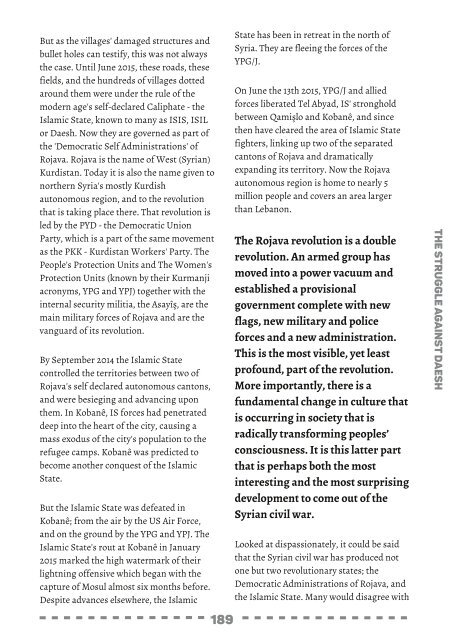STRUGGLES
Struggles-for-autonomy-in-Kurdistan
Struggles-for-autonomy-in-Kurdistan
Create successful ePaper yourself
Turn your PDF publications into a flip-book with our unique Google optimized e-Paper software.
But as the villages' damaged structures and<br />
bullet holes can testify, this was not always<br />
the case. Until June 2015, these roads, these<br />
fields, and the hundreds ofvillages dotted<br />
around them were under the rule ofthe<br />
modern age's self-declared Caliphate - the<br />
Islamic State, known to many as ISIS, ISIL<br />
or Daesh. Now they are governed as part of<br />
the 'Democratic SelfAdministrations' of<br />
Rojava. Rojava is the name ofWest (Syrian)<br />
Kurdistan. Today it is also the name given to<br />
northern Syria's mostly Kurdish<br />
autonomous region, and to the revolution<br />
that is taking place there. That revolution is<br />
led by the PYD - the Democratic Union<br />
Party, which is a part ofthe same movement<br />
as the PKK - Kurdistan Workers' Party. The<br />
People's Protection Units and The Women's<br />
Protection Units (known by their Kurmanji<br />
acronyms, YPG and YPJ) together with the<br />
internal security militia, the Asayîş, are the<br />
main military forces ofRojava and are the<br />
vanguard ofits revolution.<br />
By September 2014 the Islamic State<br />
controlled the territories between two of<br />
Rojava's selfdeclared autonomous cantons,<br />
and were besieging and advancing upon<br />
them. In Kobanê, IS forces had penetrated<br />
deep into the heart ofthe city, causing a<br />
mass exodus ofthe city's population to the<br />
refugee camps. Kobanê was predicted to<br />
become another conquest ofthe Islamic<br />
State.<br />
But the Islamic State was defeated in<br />
Kobanê; from the air by the US Air Force,<br />
and on the ground by the YPG and YPJ. The<br />
Islamic State's rout at Kobanê in January<br />
2015 marked the high watermark oftheir<br />
lightning offensive which began with the<br />
capture ofMosul almost six months before.<br />
Despite advances elsewhere, the Islamic<br />
189<br />
State has been in retreat in the north of<br />
Syria. They are fleeing the forces ofthe<br />
YPG/J.<br />
On June the 13th 2015, YPG/J and allied<br />
forces liberated Tel Abyad, IS' stronghold<br />
between Qamişlo and Kobanê, and since<br />
then have cleared the area ofIslamic State<br />
fighters, linking up two ofthe separated<br />
cantons ofRojava and dramatically<br />
expanding its territory. Now the Rojava<br />
autonomous region is home to nearly 5<br />
million people and covers an area larger<br />
than Lebanon.<br />
The Rojava revolution is a double<br />
revolution. An armed group has<br />
moved into a power vacuum and<br />
established a provisional<br />
government complete with new<br />
flags, new military and police<br />
forces and a new administration.<br />
This is the most visible, yet least<br />
profound, part ofthe revolution.<br />
More importantly, there is a<br />
fundamental change in culture that<br />
is occurring in society that is<br />
radically transforming peoples’<br />
consciousness. It is this latter part<br />
that is perhaps both the most<br />
interesting and the most surprising<br />
development to come out ofthe<br />
Syrian civil war.<br />
Looked at dispassionately, it could be said<br />
that the Syrian civil war has produced not<br />
one but two revolutionary states; the<br />
Democratic Administrations ofRojava, and<br />
the Islamic State. Many would disagree with<br />
the struggle against daesh


